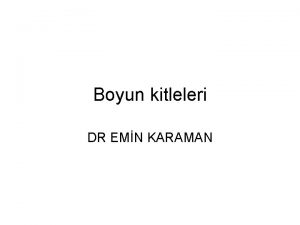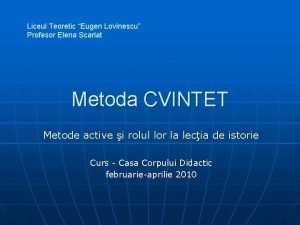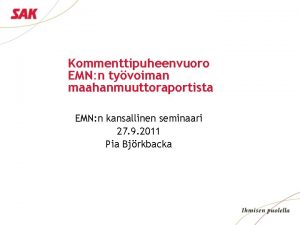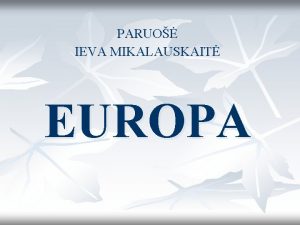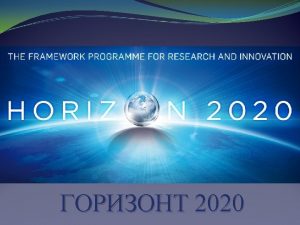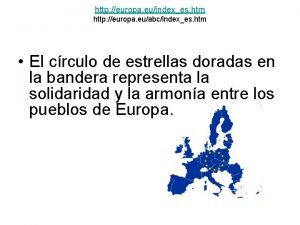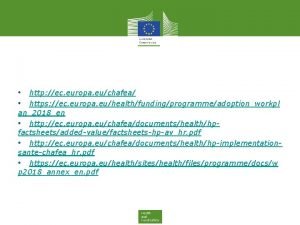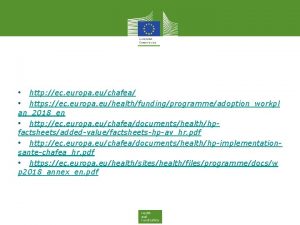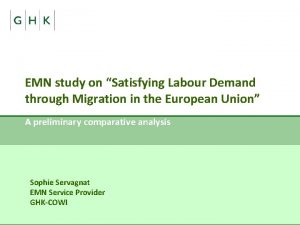http www emn europa eu EMN study on










- Slides: 10

http: //www. emn. europa. eu EMN study on “Satisfying Labour Demand through Migration” Petra van Nierop EMN Service Provider

Structure of EMN Labour Demand Study On basis of common specifications, 23 EMN NCPs each produce a National Report addressing: Methodology, including Definitions Policy and Vision for Labour Migration Institutional and legislative frameworks Mechanisms for identifying and managing labour shortages Statistical overview, incl. any data on future needs Member State Co-operation with Third Countries The findings of which are analysed in a comparative manner in a Synthesis Report.

Some Observations Europe is faced with an ageing and reduced workforce The highest numbers of third-country national migrant workers are found in the EU-15 (ES, IT, UK), the lowest in the EU-10+2 (LT, MT, SK). Of these, UK, IE and LT have the highest proportion of highly skilled third-country nationals, LT, IT and SE most skilled migrants and CZ, IT, AT and ES most low skilled. The highest numbers of third-country nationals entering the EU for work come to IT, UK and ES. Of these, the highest proportion of highly skilled were received by UK, SK and SE, most skilled by LT, BE and DE and most low skilled by CZ and ES.

Some Observations (cont. ) Overall, occupations & professions with labour shortages: engineering, social/healthcare, construction, Information Technology. Shortages both Quantitative [e. g. BE, CZ, EE, FI, FR, HU, IT, LU, LT, MT, NL, PT, SI] & Qualitative [Before, except LT, plus AT, ES, IE, SE]. Sectors most used for: Temporary (construction, agriculture, transport; e. g. DE, FR), Longer-term (social/healthcare, research, specialist; e. g. FI, SE). Irregular employment highest in construction, agriculture, social/healthcare [e. g. AT, BE, FI, HU]. Some data on return (mainly to support it, e. g. CZ, DE, ES, FR).

Member State Approaches Most have migration in their vision and strategies for employment, but priority for (EU) nationals. National policies to address shortages show preferences towards different “categories” of third-country nationals. Approaches to identify labour shortages and manage labour demand: Occupation lists (“bottleneck” positions / occupations: AT, BE, ES, FI, FR, DE, LV, LT, PL, UK) Analysis of employer needs (employers determine their needs and request hiring of TCNs: AT, BE, CZ, EE, ES, DE, HU, IE, IT, LU, MT, PL, SI, ES, SK, SE). Setting of Quotas (AT, BG, EE, HU, IT, PT, SI) or limits (UK).

Member State Approaches (Cont. ) Methods to manage labour demand include “labourmarket tests” (AT, BE, BG, CZ, DE, EE, IE, LT, LU, MT, NL, PL, SK, SI, ES, SE) and “points-based system” (UK). “Labour market tests” use Union Preference and whether employment requested is occupation with shortages, or whether quotas or other conditions have been respected. All Member States have procedures for recognition of qualifications and assessments of skills, but these vary considerably, leading to uneven treatment. Cooperation with third countries pursued via EU Mobility Partnerships and bilateral / multilateral agreements (BE, CZ, ES, FI, DE, FR, IT, LT, NL, PT, SK).

Key Findings Main overall findings: Well-managed immigration can serve to meet labour supply and alleviate labour market shortages. The EU needs to be a more attractive destination for TCNs with specific skills and competences. At national level, the study has identified a need for: Improved methods and tools to identify and forecast labour shortages; Better job-matching; Further simplification of entry & admission procedures in Member States with identified skills and competences needs; Focus on sustainability of economic migration; Better regulation and organisation of the recognition of qualifications and the validation of skills.

Key Findings (cont. ) At EU level, the study has identified: A need to assess whether further European legislative proposals are necessary. For example, there might be benefit in further simplifying entry and admission procedures, as started with Blue Card Directive & proposed Single Permit Directive. A need to promote exchanges of good practice. Further EU-level analyses and forecasting could be useful, also considering intra-EU mobility. A role for the EU in raising awareness to enhance its attractiveness.

THANK YOU FOR YOUR ATTENTION Synthesis and National Reports available from http: //www. emn. europa. eu (Under “EMN Studies”)

European Migration Network (EMN) Established in Council Decision 2008/381/EC OBJECTIVES: Meet information needs thru’ provision of up-to -date, objective, reliable and comparable information, with a view to supporting policymaking in the EU; Provide this information also to wider public. COMPOSITION: Commission (co-ordinator, assisted by 2 Service Providers) Steering Board (political guidance) EMN NCPs (each Member State plus national network. Norway also).

